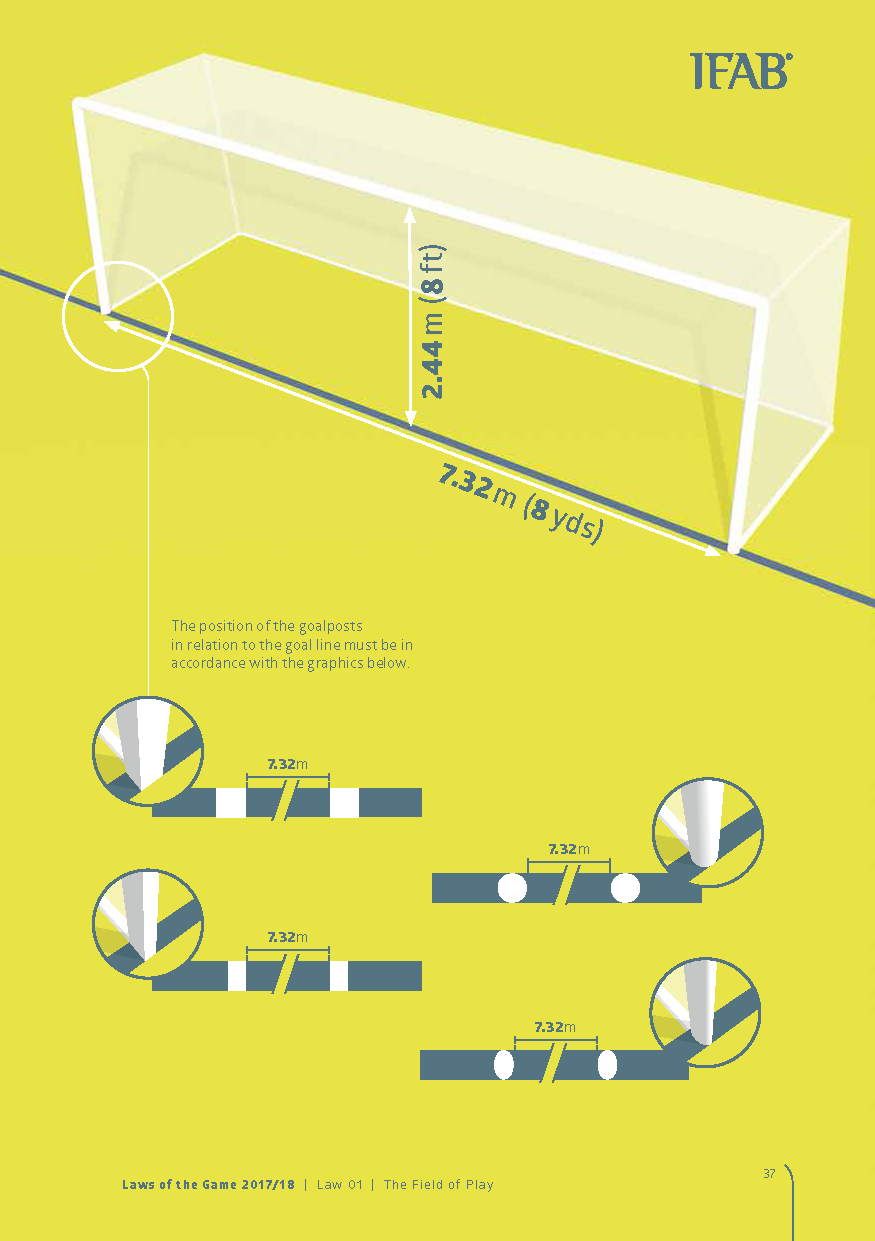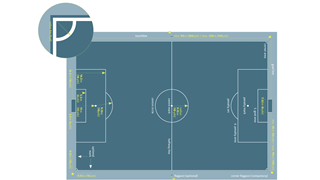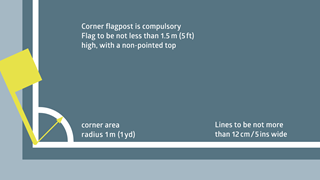Two lines are drawn at right angles to the goal-line, 16.5m (18yds) from the inside of each goalpost. These lines extend into the field of play for 16.5m (18yds) and are joined by a line drawn parallel with the goal-line. The area bounded by these lines and the goal-line is the penalty area.
Within each penalty area, a penalty mark is made 11m (12yds) from the midpoint between the goalposts.
An arc of a circle with a radius of 9.15m (10yds) from the centre of each penalty mark is drawn outside the penalty area.
The corner area is defined by a quarter circle with a radius of 1m (1yd) from each corner flagpost drawn inside the field of play.
The technical area relates to matches played in stadiums with a designated seated area for team officials, substitutes and substituted players as outlined below:
- the technical area should only extend 1m (1yd) on either side of the designated seated area and up to a distance of 1m (1yd) from the touchline
- markings should be used to define the area
- the number of persons permitted to occupy the technical area is defined by the competition rules
- the occupants of the technical area:
- are identified before the start of the match in accordance with the competition rules
- must behave in a responsible manner
- must remain within its confines except in special circumstances, e.g. a physiotherapist/doctor entering the field of play, with the referee’s permission, to assess an injured player
- only one person at a time is authorised to convey tactical instructions from the technical area
Goals
A goal must be placed on the centre of each goal line.
A goal consists of two vertical posts equidistant from the corner flagposts and joined at the top by a horizontal crossbar. The goalposts and crossbar must be made of approved material. They must be square, rectangular, round or elliptical in shape and must not be dangerous.
The distance between the inside of the posts is 7.32m (8yds) and the distance from the lower edge of the crossbar to the ground is 2.44m (8ft).
The position of the goalposts in relation to the goal line must be in accordance with the graphics.
The goalposts and the crossbar must be white and have the same width and depth, which must not exceed 12cm (5ins).
If the crossbar becomes displaced or broken, play is stopped until it has been repaired or replaced in position. If it can not be repaired the match must be abandoned. A rope or any flexible or dangerous material may not replace the crossbar. Play is restarted with a dropped ball.
Nets may be attached to the goals and the ground behind the goal; they must be properly supported and must not interfere with the goalkeeper.
SAFETY
Goals (including portable goals) must be firmly secured to the ground.

Goal-line Technology (GLT)
GLT systems may be used to verify whether a goal has been scored to support the referee’s decision.
Where GLT is used, modifications to the goal frame may be permitted in accordance with the specifications stipulated in the FIFA Quality Programme for GLT and with the Laws of the Game. The use of GLT must be stipulated in the competition rules.
PRINCIPLES OF GLT
GLT applies solely to the goal line and is only used to determine whether a goal has been scored.
The indication of whether a goal has been scored must be immediate, and automatically confirmed within one second by the GLT system only to the match officials (via the referee’s watch, by vibration and visual signal).
REQUIREMENTS AND SPECIFICATIONS OF GLT
If GLT is used in competition matches, the competition organisers must ensure that the system is certified according to one of the following standards:
FIFA Quality PRO
FIFA Quality
IMS – INTERNATIONAL MATCH STANDARD
An independent testing institute must verify the accuracy and functionality of the different technology providers’ systems in accordance with the Testing Manual. If the technology does not function in accordance with the Testing Manual, the referee must not use the GLT system and must report this to the appropriate authority.
Where GLT is used, the referee must test the technology’s functionality before the match as set out in the FIFA Quality Programme for GLT Testing Manual.
Commercial Advertising
No form of commercial advertising, whether real or virtual, is permitted on the field of play, on the ground within the area enclosed by the goal nets, the technical area or the referee review area (RRA), or on the ground within 1m (1yd) of the boundary lines from the time the teams enter the field of play until they have left it at half-time and from the time the teams re-enter the field of play until the end of the match. Advertising is not permitted on the goals, nets, flagposts or their flags and no extraneous equipment (cameras, microphones, etc.) may be attached to these items.
In addition, upright advertising must be at least:
- 1m (1yd) from the touchlines of the field of play
- the same distance from the goal line as the depth of the goal net
- 1m (1yd) from the goal net
Logos and Emblems
The reproduction, whether real or virtual, of representative logos or emblems of FIFA, confederations, national football associations, competitions, clubs or other bodies is forbidden on the field of play, the goal nets and the areas they enclose, the goals, and the flagposts during playing time. They are permitted on the flags on the flagposts.
Video Assistant Referees (VARs)
In matches using VARs there must be a video operation room (VOR) and at least one referee review area (RRA).
VIDEO OPERATION ROOM (VOR)
The VOR is where the video assistant referee (VAR), assistant VAR (AVAR) and replay operator (RO) work; it may be in/close to the stadium or at a more distant location. Only authorised persons are permitted to enter the VOR or communicate with VAR, AVAR and RO during the match.
A player, substitute or substituted player who enters the VOR will be sent off; a team official who enters the VOR will be dismissed from the technical area.
REFEREE REVIEW AREA
In matches using VARs there must be at least one RRA where the referee undertakes an ‘on-field’ review (OFR). The RRA must be:
- in a visible location outside the field of play
- clearly marked
A player, substitute or substituted player who enters the RRA will be cautioned: a team official who enters the RRA will be publicly given an official warning (or cautioned where YCs are used for team officials).



